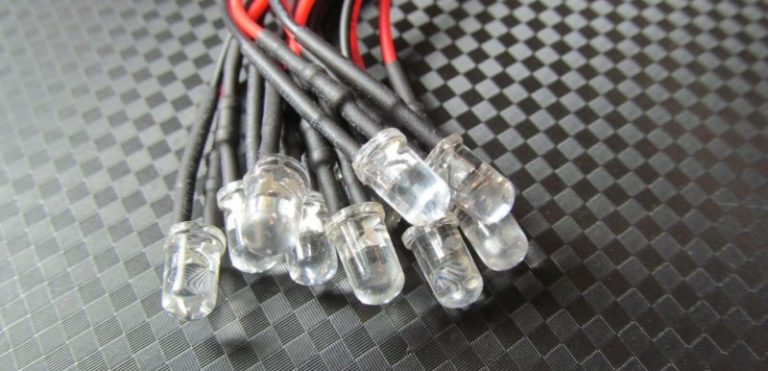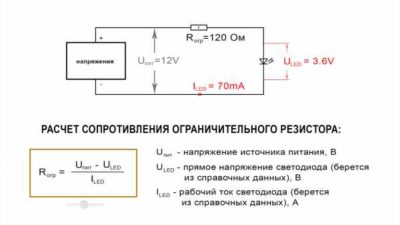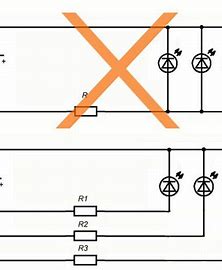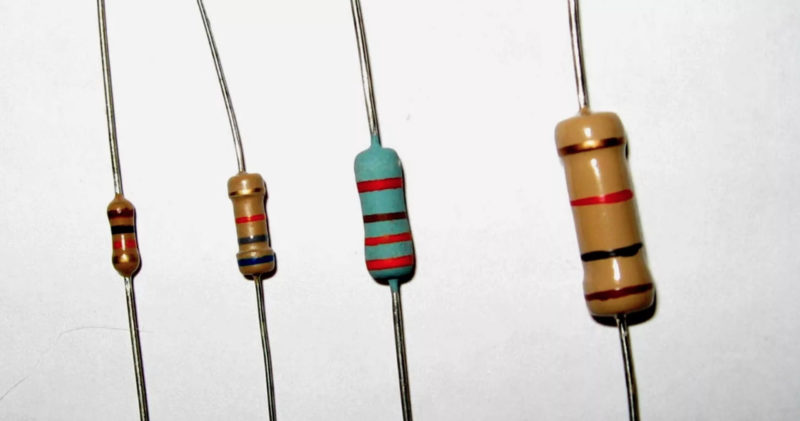How to calculate the resistor for LEDs - formulas with examples + online calculator
LEDs of different color shades have different direct operating voltages. They are set by selecting the current limiting resistance of the LED. To bring the light device to the nominal mode, you need to power the p-n junction with operating current. This is done by calculating the resistor for the LED.
Table of LED voltages depending on the color
Operating LED voltages are different. They depend on the materials of the semiconductor p-n junction and are related to the wavelength of light emission, i.e. the hue of the glow color.
A table of nominal modes of different color shades to calculate the damping resistance is shown below.
| Luminescence color | Direct voltage, V |
|---|---|
| Shades of white | 3–3,7 |
| Red | 1,6-2,03 |
| Orange | 2,03-2,1 |
| Yellow | 2,1-2,2 |
| Green | 2,2-3,5 |
| Blue | 2,5-3,7 |
| Purple | 2,8-4,04 |
| Infrared | 1.9 or less |
| Ultraviolet | 3,1-4,4 |
From the table we can see that 3 volts can be used to turn on all kinds of emitters, except for devices with a white tint, partially violet and all ultraviolet. This is due to the fact that it is necessary to "use up" some part of the power supply voltage to limit the current through the crystal.
With 5, 9 or 12 V power supplies, you can power single diodes or chains of 3 and 5-6 diodes in series.
Serial chains reduce the reliability of devices in which they are used about a factor of the number of LEDs. Parallel connection increases reliability in the same proportion: 2 chains - 2 times, 3 - 3 times, etc.
But the unprecedented duration of light sources from 30-50 to 130-150 thousand hours justifies the drop in reliability, because the service life of the device depends on it. Even 30-50 thousand hours of operation for 5 hours a day - 4 hours in the evening and 1 in the morning every day - that's 16-27 years of operation. During this time, most fixtures will become obsolete and will be scrapped. Therefore, series connection is widely used by all manufacturers of LED devices.
Online calculator for calculating LEDs
The following data will be needed for the automatic calculation:
- source or power supply voltage, V;
- nominal direct voltage of the device, V;
- direct rated operating current, mA;
- Number of LEDs in a chain or included in parallel;
- LED connection diagramdiagram(s).
Initial data can be taken from the diode's data sheet.
After entering them in the appropriate windows of the calculator press "Calculate" and you will get the nominal value of the resistor and its power.
Calculation of diode current-limiter resistor size
In practice, two types of calculation are used - graphic - according to the volt-ampere characteristic of a diode and mathematical - according to its rating data.
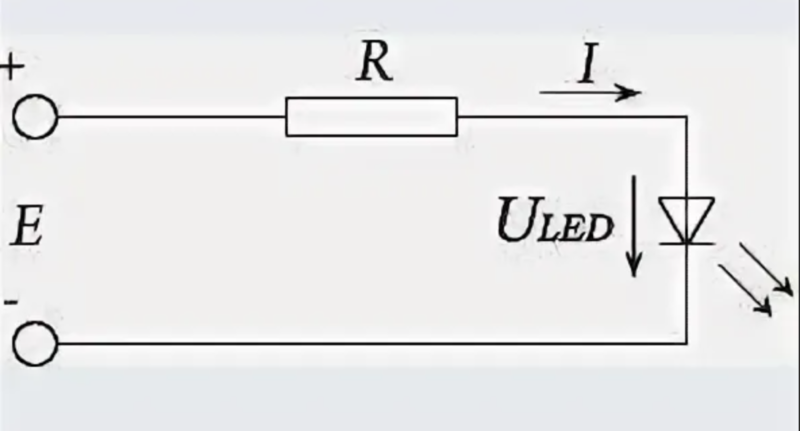
In the figure:
- Е - is a power supply source, having on the output a value of E;
- "+"/"-" - the polarity of the LED connection: "+" - anode, shown with a triangle on the diagrams, "-" - cathode, shown with a cross dash on the diagrams;
- R - current limiting resistance;
- Uled - direct, it is also working voltage;
- I - operating current through the device;
- we denote the voltage across the resistor as UR.
Then the circuit for calculating will look like this:
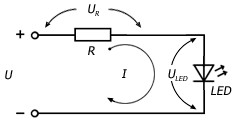
Let's calculate the resistance for current limitation. The voltage U in the circuit will be distributed as follows:
U = UR + Uled or UR + I × Rled, in volts,
where Rled- internal differential resistance of p-n junction.
By mathematical transformations we get the formula:
R = (U-Uled)/I, in Ohm.
Value U can be picked up from the data sheet values.
Let's calculate the value of current limiting resistor for Cree LED model Cree XM-L, which has a T6 bin.
Its specifications: Typical nominal ULED = 2.9 V, maximum ULED = 3.5 V, operating current ILED=0,7 А.
For calculation we use ULED = 2,9 В.
R = (U-Uled)/I = (5-2,9)/0,7 = 3 Ohm.
Calculated value is equal to 3 Ohm. We select the element with an accuracy tolerance of ± 5%. This accuracy is more than enough to set the operating point to 700 mA.
Round up the resistance value. This will reduce the current, the luminous flux of the diode and increase the reliability of the operation by a more gentle thermal mode of the crystal.
Let's calculate the required power dissipation for this resistor:
P = I² × R = 0.7² × 3 = 1.47 W
To be safe, round it up to the nearest higher value, 2 W.
Series and parallel connection schemes LEDs are widely used and show the features of these connections. Connecting the same elements in series divides the source voltage equally between them. With different internal resistances, it is proportional to the resistances. When connected in parallel, the voltage is the same and the current is inversely proportional to the internal resistances of the elements.
When LEDs are connected in series.
In a series connection, the first diode in the chain has its anode connected to the "+" of the power supply, and its cathode to the anode of the second diode. And so on up to the last diode in the chain, whose cathode is connected to "-" of the source. The current in the series circuit is the same in all its elements. That is, it is of the same magnitude through any light device. The internal resistance of an open, i.e. of the light-emitting crystal is in the tens or hundreds of ohms. If 15-20 mA is flowing through the circuit at a resistance of 100 ohms, there will be 1.5-2 V at each element. The sum of the voltages on all the devices must be less than that of the power supply. The difference is usually dampened with a special resistor, which performs two functions:
- Limits the rated operating current;
- Provides the nominal forward voltage on the LED.
When connected in parallel
Parallel connection can be done in two ways.
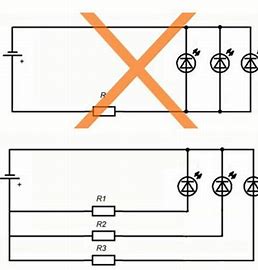
The top picture shows how to turn on is not desirable. With this connection, one resistance will ensure the equality of currents only if the crystals are perfect and the length of the supply conductors are the same. But the scatter of parameters of semiconductor devices during manufacturing does not allow to make them identical. And selecting the same ones increases the price dramatically. The difference can be 50-70% or more. Assembling the design, you will get a difference in luminescence of at least 50-70%. In addition, the failure of one radiator will change the operation of all of them: if the circuit is broken, one will go out, the others will shine brighter by 33% and become more heated. Overheating will contribute to their degradation - a change in glow shade and a decrease in brightness.
In the case of a short circuit as a result of overheating and burning of the crystal, the current-limiting resistor may fail.
The lower option allows you to set the desired operating point of any diode, even if they have different power ratings.
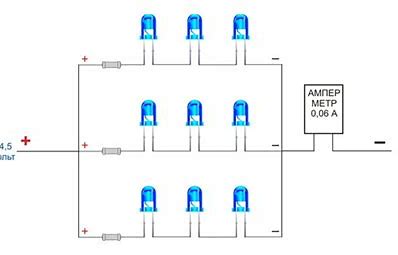
Three LED elements and one current limiting resistor are connected in series at 4.5 V. The resulting chains are connected in parallel. Each diode carries 20 mA, and all together 60 mA. At each of them you get less than 1.5 V, and at the current limiter - not less than 0.2-0.5 V. Interestingly, if you use a 4.5 V power supply, only infrared diodes with a direct voltage less than 1.5 V can work with it, or you need to increase the power supply to at least 5 V.
Direct parallel connection of LED elements (the upper part of the circuit) is not recommended because of the variation of parameters of 30-50% or more. Use a scheme with individual resistors for each diode (lower part) and connect already diode-resistor pairs in parallel.
When a single LED
Resistor for a single LED is used only when their power is up to 50-100 mW. At higher power values the efficiency of the power circuit decreases significantly.
If the direct operating voltage of the diode is much lower than the power supply voltage, the use of a limiting resistor leads to high losses. Electricity of high quality and stability, with carefully filtered ripple, provided by 3-5 types of power supply protection is not converted into light, but simply dissipated passively as heat.
For high power outputs the following drivers are used drivers - Current limiting resistors are used for high power outputs.
Using a current limiting resistor to set the operating LED - is a simple and reliable way to ensure optimal LED operation.
Video examples of a simple resistance calculation.
But with diode power over a hundred milliwatts, you need to use standalone or built-in current stabilizing sources or drivers.
